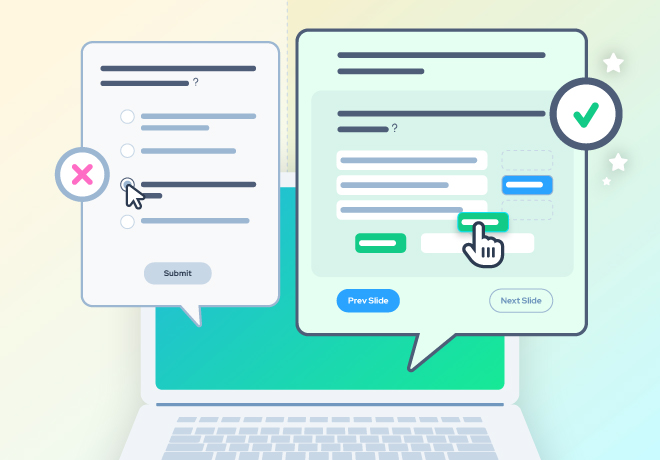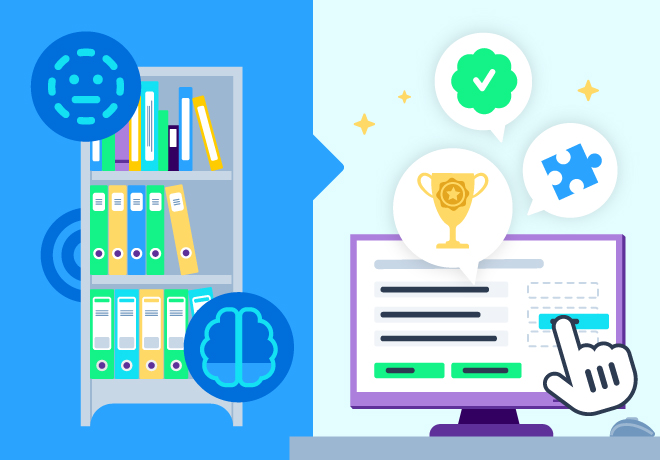
What is Instructional Design, and Why is it Important?

Related articles
Get valuable eLearning insights to your inbox.
Listen to Neovation’s Demystifying eLearning podcast generated with NotebookLM!
Listen to our podcast on your favorite platform!
You've invested in training, poured resources into materials, and dedicated valuable employee time—only to find the results fall short. Many organizations struggle to create courses that truly 'stick' or achieve measurable goals due to a lack of instructional design expertise.
Instructional design is the deliberate practice of creating learning experiences that have been scientifically proven to be effective. It's the framework for transforming your training into engaging, accessible, and objective-driven training that truly builds skills and improves performance.
In this article, we’ll explore:
- What is instructional design, and why does it matter for effective training
- Top instructional design models and practices, and how to use them
- How organizations can leverage instructional design to achieve their learning objectives
For organizations seeking to move beyond basic training and unlock their full learning potential, Neovation's Custom Learning team offers the specialized instructional design expertise needed to shape impactful, results-driven programs. Get your free quote to see how our Custom Learning team can upgrade your training with instructional design.
What Is Instructional Design?
Instructional design (ID) is the systematic process of creating, developing, and delivering learning experiences. Its core purpose is to make training effective and efficient, helping people learn new skills and improve performance by clearly defining learning goals and designing purposeful interventions.
You can trace the roots of instructional design theory to psychology and military training during World War II, which focused on systematic problem-solving. Over the decades, it has evolved from early ideas emphasizing small steps and clear objectives to embracing digital tools, the internet, and mobile devices. Today, ID incorporates advanced concepts like artificial intelligence, microlearning, and gamification to create modern learning experiences.
Instructional design is crucial in corporate and academic settings because it provides a systematic way to deliver effective training. It's particularly vital in augmenting Subject Matter Expert (SME) knowledge, bridging the gap between their deep expertise and impactful learning delivery. ID professionals accomplish this by:
- Transforming complex material into clear, engaging narratives.
- Using adult learning principles to ensure content resonates and drives retention.
- Designing content and interactions that directly align with measurable objectives.
- Translating static information into dynamic elements and simulations for skill practice.
- Converting knowledge into reusable eLearning for wider, cost-effective access.
Underpinning instructional design is a rich foundation of cognitive theories, including behaviorism, constructivism, and cognitivism. These instructional design learning theories guide designers in understanding how people learn, informing strategies like adult learning principles and systematic instructional events to maximize learning effectiveness.
What are instructional design models?
Instructional design models serve as frameworks and processes that guide the creation of effective learning solutions. They help designers systematically select the best strategies, methodologies, and technologies to maximize the learning experience and ensure successful knowledge transfer. Many existing models are variations of the widely used ADDIE model.
Here are some of the most popular instructional design models:

ADDIE Model
This standard model follows five phases: Analyze, Design, Develop, Implement, and Evaluate. Initially hierarchical, it now allows for dynamic revisions throughout the process and is known for consistently producing effective training.
.jpg)
Rapid Protoyping
This approach, including SAM (Successive Approximation Model) and Agile, emphasizes iterative development with continuous stakeholder collaboration to quickly verify designs and address issues early, working within project constraints.

Dick and Carey Systems Approach
This model views instruction as an entire system, focusing on the interrelationship among context, content, learners, and delivery components to achieve desired outcomes through iterative and parallel execution.

Merrill’s Principles of Instruction (MPI)
A task-centered approach emphasizes that learning materials should show learners what will be learned rather than just tell them. It focuses on authentic, real-world tasks through five principles: Task-centered, Activation, Demonstration, Application, and Integration. This ensures instruction is engaging, relevant, and practical.

Gagné’s Nine Events of Instruction
This framework outlines nine sequential instructional events designed to maximize learning, from gaining attention and informing objectives to providing feedback and enhancing retention and knowledge transfer.

Kemp Model
Characterized by a nonlinear or circular structure, this model emphasizes flexibility and continuous planning, design, and evaluation. It involves nine key elements, including determining goals, identifying learner needs, defining objectives, and choosing resources and strategies
Selecting and applying an instructional design model always begins with a thorough needs assessment to define organizational goals, the required skills, and the learner's characteristics. Then, the instructional designer selects the most suitable strategies and technologies, considering adult learning theories to tailor the design.
Instructional Design in Action: From Strategy to Impact
Instructional design provides a systematic framework for creating new training and analyzing and refining existing programs to maximize their effectiveness. This strategic process ensures that all learning experiences are purposeful and designed to achieve specific, measurable outcomes.
How to apply instructional design to training creation
Applying instructional design principles during the planning and creation phase is the crucial first step in transforming a training need into an effective and impactful learning solution. This strategic process acts as the blueprint for development, ensuring every element is built with purpose, clarity, and a direct path to achieving your desired outcomes.
Here is how key elements of instructional design are applied when planning and creating effective training:
- Needs analysis: Determine the necessity and focus of your training by identifying organizational goals, required employee skills, and the desired learning outcomes.
- Learner profiles: By analyzing your target audience and applying relevant instructional design learning theories, your training is tailored to the specific needs, experiences, and preferences of learners, ensuring relevance.
- Goal alignment: Ensure all aspects of your training directly support the organization's broader strategic objectives and align with your existing SME knowledge. This will make the learning experience impactful and purposeful, guided by sound instructional design principles.
- Content mapping and storyboarding: Complex information is clarified and structured into a logical narrative, with a detailed storyboard serving as the blueprint for the course, ensuring a cohesive learning journey.
- Defining learning objectives: Clear, measurable learning objectives are established, describing the specific behavior, knowledge, or skill a learner will acquire and how it will be assessed.
- Media and interactivity planning: The right mix of multimedia, including videos and graphics, and interactive elements, such as simulations and scenarios, is selected to enhance engagement and practical application.
- Assessment and knowledge checks: Purposeful assessments and knowledge checks are integrated throughout the training to evaluate understanding, reinforce learning, and measure the achievement of objectives.

However, the instructional design process doesn't end at delivery. The same systematic principles are equally powerful when analyzing learner feedback and performance data to continuously refine and improve training that has already been delivered.
How to refine your training using instructional design
Instructional design’s systematic and iterative approach makes it an essential tool for evaluating learner performance and continuously refining your programs for greater impact.
A core component of refining training is the rigorous evaluation of learner performance. Instructional designers focus on what knowledge was actually acquired and whether the training led to measurable behavioral changes. This is done through various assessment instruments—from pre- and post-tests to knowledge checks and practice problems—which measure mastery against objective standards.
The insights gained from the evaluation feed directly into the iterative process of improving the training. This continuous improvement cycle is achieved through several key methods:
- Iterative models: Frameworks like ADDIE and SAM, core instructional design models, are inherently iterative, with built-in phases for evaluation and revision to ensure problems are addressed and the training is consistently effective.
- Content enhancements: Existing courses can be updated to reflect new information or user feedback. This can range from minor content reviews to significant overhauls that involve rewriting content and adding new interactive elements.
- Quality assurance loops: Rigorous quality assurance (QA) processes, which include comprehensive testing and stakeholder feedback, are essential for identifying areas for improvement and ensuring that the training continues to meet high standards. By embracing this cycle of evaluation and iteration, organizations can ensure their training remains effective and consistently aligned with their evolving goals. This continuous improvement process is what turns good training into great training.
Custom instructional design: Why one-size doesn't always fit all
Organizations often partner with specialized instructional design vendors to overcome hurdles and develop personalized learning journeys. Key reasons for this strategic choice include:
- Instructional design consultants move beyond generic training by creating custom solutions aligned with your specific goals, culture, and learner needs, using interactive design to make complex topics clear and engaging.
- Vendors provide a multidisciplinary team of instructional designers, developers, and project managers, offering a depth of experience in learning theory and development that is often missing in-house.
- Vendors have the capacity and efficient processes to manage projects of any scale, ensuring tight deadlines are met without compromising quality or pulling your internal teams from their core duties.
- Organizations turn to vendors for projects requiring specific skills not available internally, such as developing complex simulations, creating multilingual courses, or ensuring accessibility compliance.
- For those unsure how to begin, vendors provide a clear, collaborative process, guiding you from initial needs analysis and content organization all the way to final delivery and support.
These reasons highlight why choosing a custom instructional design theory partner is not just about overcoming development hurdles but unlocking the benefits only a custom instructional design partner can deliver.
Modern training formats and engagement tools
Instructional design transforms static information into dynamic learning experiences by strategically leveraging a wide range of training formats and interactive elements. This process ensures that every piece of content is delivered in the most effective, engaging, and memorable way possible. By selecting the appropriate medium for the message, instructional design makes learning impactful and efficient.

A key function of instructional design is to select and develop the most effective tools to facilitate learning:
- Content conversion: Transforming existing materials like PowerPoint presentations, policy documents, or live training sessions into interactive and scalable eLearning courses.
- Interactive features: Incorporating branched scenarios, blended eLearning, drag-and-drop activities, and gamification to actively engage learners and reinforce key concepts.
- Simulations and microlearning: Developing realistic simulations for safe, hands-on skill practice and creating bite-sized microlearning modules for focused, on-demand content.
- Rich multimedia: Utilizing explainer videos, custom graphics, and professional animations to simplify complex topics and enhance visual storytelling. Furthermore, a core instructional design principle is designing accessible learning that is inclusive for all:
- Adherence to standards: Designing and updating courses to meet Web Content Accessibility Guidelines (WCAG) 2.0 AA to ensure broad usability and accessibility.
- Inclusive features: Implementing synchronized closed captioning, full keyboard navigation, alt text for visuals, and proper color contrasts for users with disabilities.
- Multilingual support: Offering course translation and professional narration in numerous languages to support diverse and global workforces.
By strategically combining these interactive formats and adhering to foundational instructional design principles of accessibility, vendors can ensure the final version of the training is not only practical but also inclusive. This thoughtful approach yields a powerful learning experience that effectively engages a diverse audience and achieves the desired organizational outcomes.
Measuring Success: Instructional Design That Delivers
Effective training should deliver precise, measurable results, and instructional design provides the systematic framework to achieve and evaluate that success. This approach moves beyond simple course completion, focusing on tangible impacts on your learners and your organization. By strategically aligning content with specific objectives from the start, every aspect of the training's effectiveness can be assessed.
The impact of well-designed training is determined by focusing on several key areas:
Key performance metrics & ROI
Instructional design aims to drive concrete business results. Effectiveness is measured by tracking improvements in productivity, compliance rates, and return on investment (ROI), such as savings from converting live sessions to eLearning. This focus ensures a clear and positive business impact from your training.
Learner engagement
A critical indicator of success is the level of engagement your learners exhibit. This is measured through the use of interactive elements, such as scenarios, gamification, and multimedia, which are designed to capture attention, motivate learners, and lead to higher completion and satisfaction rates.
Behavior change
The ultimate goal of training is to foster real behavioral change. This is assessed by creating opportunities for real-world application, such as in realistic simulations where learners can practice new skills and make decisions in a safe environment, thereby demonstrating actual competence and knowledge retention.
This data-driven approach provides clear evidence of learning effectiveness and its direct contribution to your organizational goals, setting the stage for continuous improvement.
Instructional Design FAQs
What is instructional design?
Instructional design (ID) is the systematic process of creating effective, efficient, and engaging learning experiences. The practice involves analyzing learner needs, defining clear goals, and then designing and delivering an instructional "intervention" to meet those goals. It is historically rooted in cognitive psychology and systems engineering.
What are the main models of instructional design?
Most instructional design models are variations of ADDIE and are based on scientific learning principles. The main models from the text include:
- ADDIE Model: The most common model, it follows five phases: Analyze, Design, Develop, Implement, and Evaluate.
- Rapid Prototyping: An iterative model focused on creating and testing prototypes early to solve problems efficiently.
- Dick and Carey Systems Approach Model: Views instruction as an integrated system, focusing on the relationship between context, content, and learners.
- Guaranteed Learning (IDLS): Emphasizes task analysis, criterion-based testing, and the validation of interactive materials through performance activities.
How do you create effective learning objectives?
Effective learning objectives state precisely what a learner will be able to do after instruction. Based on the work of Robert F. Mager, they must contain three parts:
- Behavior: The skill or knowledge to be demonstrated.
- Condition: The context in which the skill will be performed.
- Criteria: The standard used to measure performance.
These objectives are often classified using Bloom's taxonomy of learning domains (cognitive, psychomotor, and affective).
How do you measure the effectiveness of instruction?
Effectiveness is measured through both formative evaluation (during the design process) and summative evaluation (after the course is complete). Key methods include using assessment instruments like quizzes and post-tests, tracking performance against predefined goals, collecting learner feedback through surveys, and observing improvements in business outcomes like compliance rates or reduced classroom time. Modern methods also use real-time data capture to gauge success.
Don’t Leave Effective Training Up to Chance
Instructional design is more than just creating materials; it is the essential framework for transforming knowledge into impactful learning. By systematically analyzing learner needs, structuring complex information, and leveraging dynamic formats like simulations and interactive media, it ensures that every training initiative is purposeful, engaging, and strategically aligned with your organizational objectives.
Neovation’s Custom Learning: Your Partner for Bespoke Training
Organizations benefit immensely from custom-made training because it moves beyond generic solutions to align precisely with their unique goals, culture, and learner needs, significantly enhancing employee engagement and knowledge retention. Customized instructional design services provide a more effective, scalable, and cost-efficient way to deliver a consistent, high-quality learning experience professionally designed to reflect your brand.
Our Custom Learning team helps organizations across industries achieve this by providing a specialized, multidisciplinary group of experts to manage the entire development lifecycle, from initial concept to final delivery. We overcome common challenges, such as complex content, tight timelines, and budget constraints, through proven instructional design, efficient project management, and flexible, transparent processes, ensuring high-impact training solutions.
In a world where employee development is a critical driver of success, leaving training effectiveness to chance is no longer an option. Applying the instructional design theory is the most reliable way to move beyond frustrating, low-impact courses and create learning experiences that genuinely build skills, change behavior, and deliver a measurable return on your investment.

Alex is an experienced writer and marketer with an interest in all things education. With a background in literary theory, technical writing, and document design, he is interested in how learners make meaning from language and how to create meaningful connections through writing.
Become part of our L&D community
We publish a new learning hub article — full of useful, practical topics — weekly.
Not sure where where you want to start? Jump into one of our recently published articles and see where it takes you!








-svg.svg)
-svg.svg)
-svg.svg)
-svg.svg)